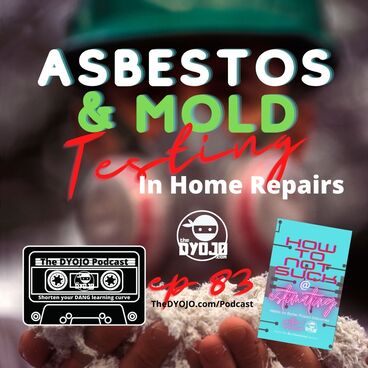|
Contractors in the propeprty restoration industry will often come across hazardous materials, two of which are asbestos and mold. Episode 83 of the DYOJO Podcast discusses these key items of concern as well as the precautions that should accompany for proper testing and removal. Listening to this episode will inform owners, managers, and restoration professionals on why they need to know if asbestos or mold is being dealt with. This article will review how the intentional restorer should structure their mindset and habits for success when dealing with mold and asbestos in construction materials. Mold and Asbestos in Construction MaterialsThere exists a dangerous mindest that asbestos containing materials (ACM) are a thing of the past, the reality is that they are still found in current construction and building materials. These materials can be hazardous to people’s health, including workers, occupants, and anyone who comes in contact with the structure. Asbestos is a legally regulated material. The restoration contractor MUST be mindful of what materials they are dealing with before any kind of demolition is performed. Asbestos becomes troublesome when it becomes friable (aka airborne) when stirring up dust while making flood cuts or removing other materials. Air movement over an area of drywall that has microbial growth on it, in an attempt to dry it, can spread mold spores throughout the home and potentially spread mold to previously unaffected areas. Mold and Asbestos at the WorksiteDue to the particulate matter of asbestos and mold, their protocols are similar. The contractor will need to make sure they are in compliance with regulations and standards. Each state is unique in how they handle asbestos, so each contractor will need to be mindful of the rules in the state (or states) they work in. Asbestos is regulated by law - there is no straying from the regulations without consequences, which could include steep fines and imprisonment. The contractor will want to be mindful of these so proper protection of their workers will be provided (respirators for technicians, properly sized via fit testing by a certified fit tester, etc.)
Mold and Asbestos Removal Best PracticesThe Institute of Inspection Cleaning and Restoration Certification (IICRC) has published ANSI standards for water damage mitigation and mold remediation. These property restoration standards are voluntary compared to those that are regulated for asbestos and other hazardous materials. The IICRC S520 is what outlines consensus standards for professional mold remediation. Owners, managers, and professionals who seek best practices will find these standards and training to be essential to their operations. The IICRC standards are a solid starting point, but restoration and remediation contractors may have to deviate when appropriate. Whether a project is typical or non-standards, the job is only as good as it is documented, and deviations should follow a clearly executed plan. Contractors should be careful not make any health claims when it comes to mold or asbestos. The job of the contractor is to successfully remediate the mold or abate the asbestos in the structure. Doctors are the ones that should discuss the health concerns of the homeowner, and the contractor should direct any health concerns to those qualified professionals. Intentional restoration contractors and their team members place a high priority on educating themselves on the scopes of work that they plan to perform so that they can keep their clients and their team members safe. Owners, managers, and contractors will do well to keep themselves out of needless legal trouble through studying and executing industry best practices.  GUEST CONTRIBUTOR: This article was written by Tiffany Acuff. Through a chance meeting of a friend, I was brought into the restoration industry. I have seen just about every aspect of working for a restoration contractor. I love this industry because it allows me to make a difficult situation a little bit better. I am constantly on the lookout for ways to contribute to the restoration industry as a whole so that we don't stay stagnant and continue to be leaders of mitigation and preservation. Tiffany has assisted in editing the last three books from The DYOJO, including the latest one, How To Suck Less At Estimating.
7 Comments
8/8/2022 07:14:12 am
I didn't realize that asbestos was used in so many homes. It makes sense that finding out if that's in my home would be important. I'll be sure to work with a professional to see if they can figure out if there's asbestos on my property.
Reply
1/9/2023 12:04:58 pm
Wow, it stood out to me when you explained that asbestos can still be found in current construction materials. As far as I know, asbestos can cause serious health problems that won't develop until later in life. Working with an asbestos abatement company would probably be best if you are worried that you are dealing with this material.
Reply
5/19/2023 10:21:29 am
It was interesting to me when you mentioned that asbestos is a legally regulated material. I would imagine that there is a legal process that needs to be followed when asbestos needs to be removed. It seems like you could get in trouble by attempting to remove asbestos without the help of a professional.
Reply
5/24/2023 06:56:10 pm
I appreciate your concern regarding mold and asbestos in construction materials. Both mold and asbestos can pose significant health risks if not handled properly. Allow me to provide some information to help you understand these issues better.
Reply
5/29/2023 03:21:32 am
Thank you for sharing the link to your blog post titled "Mold and Asbestos in Construction Materials." I had the opportunity to read through the content, and I appreciate the valuable information you provide on the presence of mold and asbestos in construction materials and their potential health risks.
Reply
6/12/2023 02:45:57 am
Great content! Keep sharing such valuable posts. If you're seeking professional services, be sure to explore
Reply
8/14/2023 05:22:36 am
Mold and asbestos awareness in construction materials is essential for creating healthy living spaces. Mold thrives in damp conditions, while asbestos lurks in older structures. By addressing both concerns in construction, we can ensure not only the quality of our homes but also the well-being of those who inhabit them.
Reply
Leave a Reply. |
Words
The DYOJO - helping contractors shorten Archives
June 2024
Categories
All
EstimatingMarketingInsurance ClaimsLeadership |
|
| |||||||


 RSS Feed
RSS Feed
